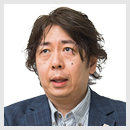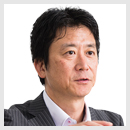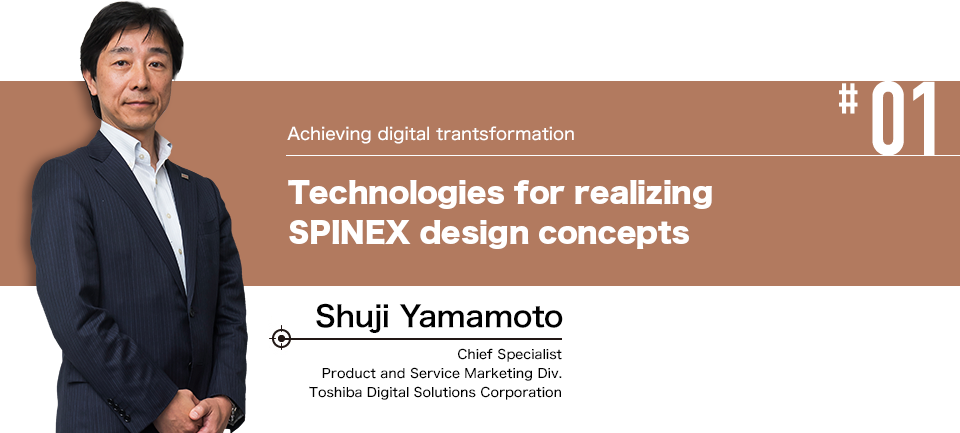Since first being made commercially available, Toshiba's SPINEX IoT (Internet of Things) architecture has been extremely well-received by a variety of customers in the industrial and social fields, and has been used in the field to resolve problems using the potential of the IoT. Our mission is to apply SPINEX design concepts digital twins, edge computing, and open partnerships to various operational issues, producing effective solutions that accelerate customer innovation. This is achieved by processing, analyzing, and leveraging time-series data collected from IoT networks in factories and in the field. We provide greater security for the massive collections of data used in these solutions while creating new value which spans company and industry lines. Let's look at some of the notable products, services, and measures that make up the SPINEX platform for producing new value from the worksite.
Worksites leveraging SPINEX
This spring, the Ministry of Economy, Trade and Industry announced the new Japanese industrial policy concept of “Connected Industries.” Work is underway in reflecting this concept in concrete measures. For Germany's “industrie 4.0” national project and the U.S. “Industrial Internet,” concrete architecture and system creation began from the policy conceptualization stage, and these activities are accelerating. We are now at the stage where corporate and societal reforms which leverage the IoT need actual implementation in the field, not mere concepts.
A critical part of field-level implementation is the systematization of practice-based expertise and
architecture. Overall architecture (including services), which encompasses business information
usage and operation, is designed, and not only are standards and de facto standards used, but open
partnerships are thoroughly leveraged to achieve the results that are possible through
collaboration. Our core technologies and products are then used in areas which require the
technologies and features that Toshiba can provide.
Toshiba systematically merges advanced technologies such as IoT, cloud, and AI (Artificial
Intelligence) technologies, with its extensive practical experience and expertise, cultivated in the
field in a wide range of businesses such as semiconductors and social infrastructure. This is
supplied in the form of the innovative IoT architecture “SPINEX.” Toshiba provides
powerful support for customer digital transformation.
SPINEX's features include its use of “digital twins,” which digitally replicate site
activities and environments in real-time, “edge computing,” which performs real-time
edge (site) processing and collaborative processing with the cloud, and “media
intelligence”, which is the technology for knowledge processing utilizing speech and images,
developed through Toshiba's long years of experience to support communication between human and
machines. These technologies are used to sense and analyze site data. They are core technologies
that are leverage these data in operations, and are shaped by a precisely defined architecture of
advanced technologies based on site use.
Since before the announcement of SPINEX in November 2016 Toshiba has engaged in leading overall
architectures, such as developing and improving the products and services used in SPINEX by
providing big data platforms combining middleware products and services, and by developing improved
security. These platform technologies and technologies developed by our global partners, have made
it possible to connect all types of information, people, as well as diverse products, services, and
technologies, in real time (Fig. 1).
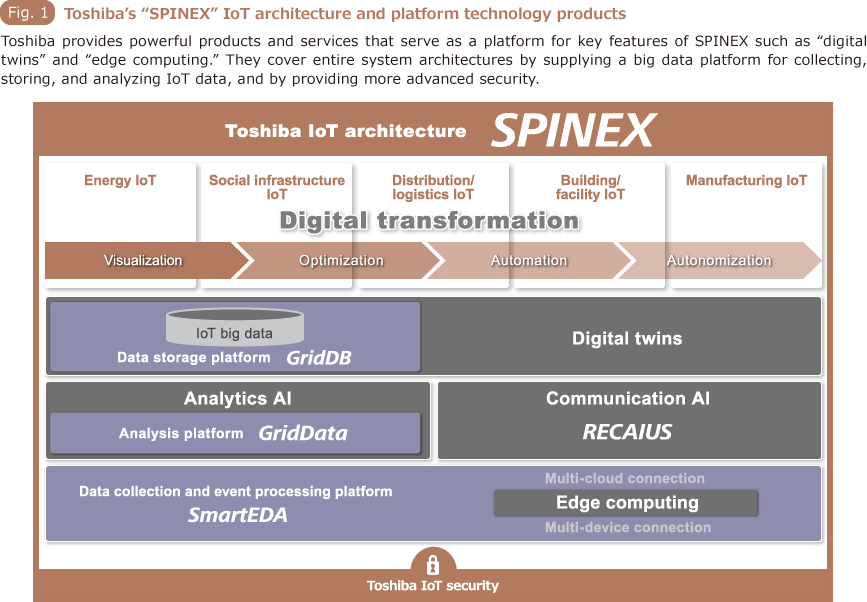
Click here to move to the top of this page.
Unique middleware and databases supporting data collection, storage, and analysis
Edge computing is a method for processing massive collaborative distributed
data, such as time-series sensor data, images, and videos, between edges (sites) and the cloud. This
method reduces network loads while improving the immediacy of site data processing and state
detection.
Toshiba has developed SmartEDA, a data collection and event processing solution which is effective
for implementing edge computing. SmartEDA can be placed on site controllers and gateways to collect
large amounts of data from devices and sensors and performs initial data processing. It can detect
real-time abnormality and control site device and equipment autonomously, as well as forecast sign
detection of imminent system failures. It can also identify abnormal values, immediately sending
this data to the cloud while sending problem-free data at regular intervals. This freely
configurable transmission control reduces the network loads while performing data editing aligned
with user needs, supporting collaborative distributed processing.
* SmartEDA is introduced in detail in #02.
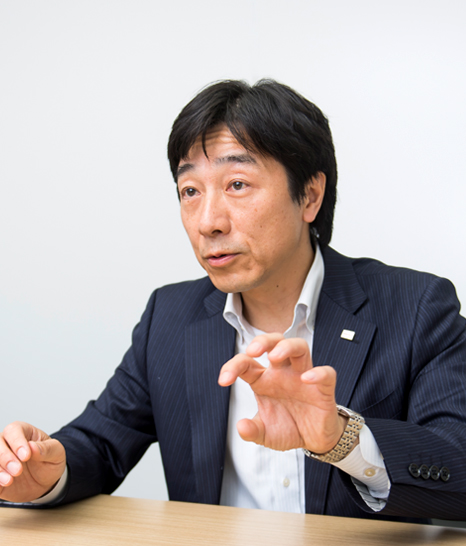
Digital twins together with edge computing are the central elements that
support digital transformation by SPINEX. Large amounts of collected data are used to accurately
reproduce real-world events in digital representation in real time (mapping). For example,
conditions within a plant can be accurately monitored, and signs of production line delays,
stoppages, and product defects are rapidly detected, enabling prompt improvements. Thus production
site productivity and quality are dramatically improved.
The key issue is how to best store the explosively increasing sensor data and process it efficiently
while accommodating the specific characteristics of individual customer operations and changes in
their environments. Toshiba has developed and released GridDB, a high-speed, scalable data
management solution optimal for representing phenomena and identifying signs of issues through the
use of digital twins. GridDB uses a unique IoT-oriented data model appropriate for managing
time-series data and three-dimensional spatial data, ensuring data consistency on a per-container
basis. Necessary data is placed not only in storage media but in memory as well, and is processed
efficiently. Its overwhelming scalability, allowing capacity and performance expansion simply by
adding servers, has been proven by third-party benchmark tests. Toshiba provides GridDB globally as
open source software, and it is even being used in verification testing at a US university.
* GridDB is introduced in detail in #03.
Click here to move to the top of this page.
An industrial big data solution that accelerates site action
Toshiba provides a big data solution to ensure that the big data accumulated through the
implementation of edge computing and digital twins is smoothly tied into action on work site.
In addition to SmartEDA and GridDB, the GridData analysis solution performs high-speed processing
across large amounts of both internal and external data of a corporatation. GridData applies open,
industry-standard analytics technology and cutting-edge algorithms, with Toshiba's unique event
pattern analysis technology and AI at a high level. Thus all-in-one support for “collection
-> storage -> prediction and analysis -> visualization -> utilization” processes
is performed. These technologies are backed by the Toshiba Group's experience through using big data
in semiconductor plants and other worksites. Inference engines are run in the edge sections, near
devices, to flexible collect, edit, and convey sensing data, providing functions aimed at achieving
even more advanced, truly edge rich platforms.
Click here to move to the top of this page.
Multilayer security protection for open systems
Even in environments poised to receive the full benefits provided by SPINEX, when we apply results to
business, the security of control systems, which increasingly use multi-device, multi-cloud
connectivity and are increasingly open, is important.
Toshiba has extensive technologies developed from minute semiconductor products to large industrial
machines, experience of the construction and operation of critical control systems used in social
infrastructure, and operation expertise regarding the information systems that have provided to over
200,000 employees with hundreds of thousands of information devices through years. We leverage these
experience in the development and operation of security systems for use with the IoT. Of course, we
are also at the forefront of deploying and using the latest software, hardware, and solutions for
combatting cyber-attacks, both in Japan and abroad. We provide OT (Operational Technology) security
solutions that offer multi-layer protection from cyber security threats for edges such as devices
and IoT gateways, as well as networks, clouds, and entire systems.
By using optimal security design based on risk assessment form the IoT system design phase, we provide SPINEX with safety that extends from devices to clouds. We provide support for secure data collection, storage, analysis, and action, engage in open and active corporate collaboration, and contribute to greater competitiveness by leveraging a diverse range of data.
Click here to move to the top of this page.
Global open partnerships
Our business division and R&D division engineers actively participate in external organizations activities such as the Industrial Internet Consortium (IIC), Industrial Value Chain Initiative (IVI), Robot Revolution Initiative (RRI), OpenFog Consortium, and EdgeX Foundry. In our IVI activities we have performed test demonstration of SPINEX solutions, which are used as IoT architechture, testing its conformance with the IVRA IVI reference architecture. We are also taking action with respect to trends in Germany's Industrie 4.0, America's Industrial Internet, and the like. We were at the forefront of adoption of Industrie 4.0's OPC-UA industrial protocol standard in our products, and are now intensifying our efforts related to OpenAAS (Open Asset Administration Shell), which standardizes asset configuration information to improve information connectivity, operability, and speed. We collaborate with numerous partners, creating the No. 1 products in each field and dynamically adopting advances in leading technologies (Fig. 2).
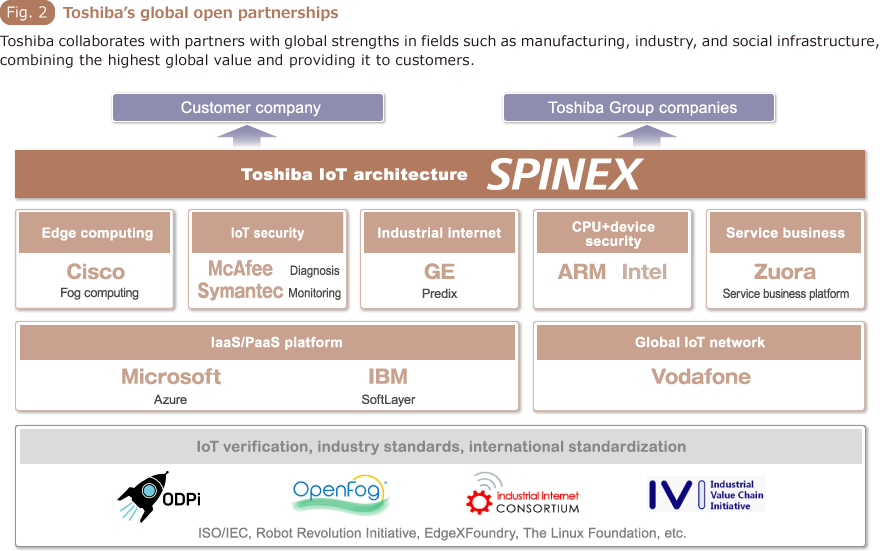
We've introduced some of the notable, iconic products, services, and measures that make up SPINEX. These products and services are used in and provided by the IoT Standard Pack visualization and remote monitoring service and the next-generation manufacturing solutions composed of SPINEX's fundamental components. Toshiba is tailoring SPINEX's IoT architecture to individual customer operations, such as though applications including asset management and O&M (Operation & Maintenance) service solutions, hybrid cloud integration, and API (Application Programming Interface) management systems. SPINEX IoT architecture is used in diverse products, services, and solutions, and we continue to strive to achieve further advances.
Toshiba's architects and engineers have visited various workplaces, selecting the optimal core technologies found therein and integrating them, culminating in the creation of SPINEX, which provides true value to all customers. We provide innovative technologies and the sincere support, perfectly aligned with customer desires, to assist in the creation of business through digital transformation.
SPINEX is introduced in detail in DiGiTAL T-SOUL Vol.21
#01.
IoT Standard Pack is introduced in detail in DiGiTAL T-SOUL Vol.21 #02.
* The corporate names, organization names, job titles and other names and titles appearing in this article are those as of July 2017.
